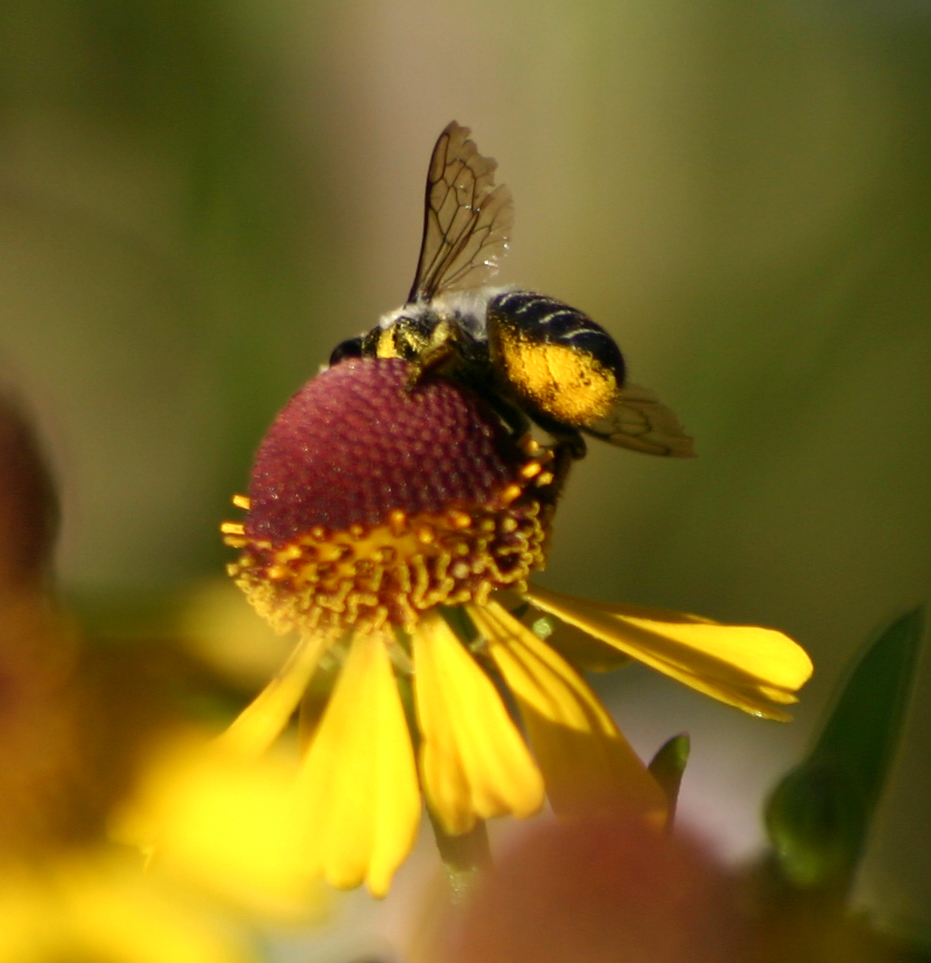scopa (biology) on:
[Wikipedia]
[Google]
[Amazon]
 A scopa (plural scopae; Latin for "broom") is any of a number of different modifications on the body of a non-parasitic bee that form a
A scopa (plural scopae; Latin for "broom") is any of a number of different modifications on the body of a non-parasitic bee that form a 

 A scopa (plural scopae; Latin for "broom") is any of a number of different modifications on the body of a non-parasitic bee that form a
A scopa (plural scopae; Latin for "broom") is any of a number of different modifications on the body of a non-parasitic bee that form a pollen
Pollen is a powdery substance produced by most types of flowers of seed plants for the purpose of sexual reproduction. It consists of pollen grains (highly reduced Gametophyte#Heterospory, microgametophytes), which produce male gametes (sperm ...
-carrying apparatus. In most species of bees, the scopa is simply a dense mass of elongated, often branched, hairs (or setae
In biology, setae (; seta ; ) are any of a number of different bristle- or hair-like structures on living organisms.
Animal setae
Protostomes
Depending partly on their form and function, protostome setae may be called macrotrichia, chaetae ...
) on the hind leg. When present on the hind legs, the modified hairs are, at a minimum, on the tibia
The tibia (; : tibiae or tibias), also known as the shinbone or shankbone, is the larger, stronger, and anterior (frontal) of the two Leg bones, bones in the leg below the knee in vertebrates (the other being the fibula, behind and to the outsi ...
, but some bees also have modified hairs on the femur
The femur (; : femurs or femora ), or thigh bone is the only long bone, bone in the thigh — the region of the lower limb between the hip and the knee. In many quadrupeds, four-legged animals the femur is the upper bone of the hindleg.
The Femo ...
and/or trochanter. A few bees have, in addition to the leg hairs, many modified hairs on the ventral surface of the abdomen which are also used in pollen transport; one family of bees, the Megachilidae
Megachilidae is a cosmopolitan family of mostly solitary bees. Characteristic traits of this family are the restriction of their pollen-carrying structure (called a '' scopa'') to the ventral surface of the abdomen (rather than mostly or exclu ...
, lack modified leg hairs, but have an extensive scopa on the underside of the abdomen (see photo).
Honey bee
A honey bee (also spelled honeybee) is a eusocial flying insect within the genus ''Apis'' of the bee clade, all native to mainland Afro-Eurasia. After bees spread naturally throughout Africa and Eurasia, humans became responsible for the ...
s and bumblebee
A bumblebee (or bumble bee, bumble-bee, or humble-bee) is any of over 250 species in the genus ''Bombus'', part of Apidae, one of the bee families. This genus is the only Extant taxon, extant group in the tribe Bombini, though a few extinct r ...
s have a more highly-developed structure than the scopa: the corbicula, or pollen basket
The pollen basket or corbicula (plural corbiculae) is part of the tibia on the hind legs of the female of certain species of bees. They use the structure in harvesting pollen and carrying it to the nest or hive where it is used as food by the col ...
. Various species of bees have other types of modified hairs that collect pollen, floral oils, or other chemicals from plants; such hairs may be borne on the face, mouthparts, or the front or middle legs, but such hairs are not called scopae. The term "scopa" is restricted to hairs adapted to the transport of pollen.
Some species of bees transport pollen internally in the crop
A crop is a plant that can be grown and harvested extensively for profit or subsistence. In other words, a crop is a plant or plant product that is grown for a specific purpose such as food, Fiber, fibre, or fuel.
When plants of the same spe ...
, and they lack a scopa, as do kleptoparasitic bees, which do not gather their own pollen.Proctor, M.; Yeo, P.; Lack, A. (1996). ''The Natural History of Pollination''. Timber Press, Portland, Oregon


See also
* CorbiculaReferences
{{DEFAULTSORT:Scopa (Biology) Pollination Bees Arthropod anatomy